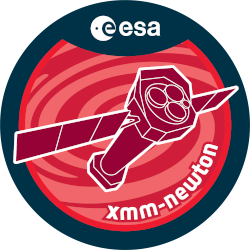

| Proposal ID | 067109 |
| Title | The X-ray source populations of different stellar generations in the LMC |
| Download Data Associated to the proposal | https://nxsa.esac.esa.int/nxsa-sl/servlet/data-action-aio?obsno=0671090101 |
| DOI | https://doi.org/10.5270/esa-62hc8np |
| Principal Investigator, PI | Dr Vallia Antoniou |
| Abstract | We propose XMM-Newton observations of 8 regions of the LMC with the strongestclean star-formation episodes in the ~6-50 Myr age range. These observationswill probe the X-ray source populations in regions of different stellar content,down to a luminosity of ~10^33 erg/s in our nearest star-forming galaxy. Fromtheir optical counterparts we will classify the X-ray sources as supergiants orBe/X-ray binaries (SG- or Be-XRBs), while based on X-ray spectra and timinganalysis we will identify X-ray binary pulsars. These results will address theconnection between stellar and different XRB sub-populations. The proposedobservations will complement previous X-ray studies of the LMC as well asinvestigations in other galaxies where these faint XRB populations cannot be observed. |
| Publications |
|
| Instrument | EMOS1, EMOS2, EPN, OM, RGS1, RGS2 |
| Temporal Coverage | 2012-02-04T11:53:10Z/2012-02-04T20:45:03Z |
| Version | 17.56_20190403_1200 |
| Mission Description | The European Space Agencys (ESA) X-ray Multi-Mirror Mission (XMM-Newton) was launched by an Ariane 504 on December 10th 1999. XMM-Newton is ESAs second cornerstone of the Horizon 2000 Science Programme. It carries 3 high throughput X-ray telescopes with an unprecedented effective area, and an optical monitor, the first flown on a X-ray observatory. The large collecting area and ability to make long uninterrupted exposures provide highly sensitive observations. Since Earths atmosphere blocks out all X-rays, only a telescope in space can detect and study celestial X-ray sources. The XMM-Newton mission is helping scientists to solve a number of cosmic mysteries, ranging from the enigmatic black holes to the origins of the Universe itself. Observing time on XMM-Newton is being made available to the scientific community, applying for observational periods on a competitive basis. |
| Creator Contact | https://www.cosmos.esa.int/web/xmm-newton/xmm-newton-helpdesk |
| Date Published | 2013-02-18T00:00:00Z |
| Last Update | 2025-08-04 |
| Keywords | "XMM", "optical counterparts", "faint xrb populations", "XMM-Newton", "xray spectra", "stellar content", "xray binary pulsars", "star formation episodes", "xmm newton", "xrb sub populations", "xray sources", "stellar generations", "myr age range", "star forming galaxy", "xray source populations" |
| Publisher And Registrant | European Space Agency |
| Credit Guidelines | European Space Agency, Dr Vallia Antoniou, 2013, 'The X-ray source populations of different stellar generations in the LMC', 17.56_20190403_1200, European Space Agency, https://doi.org/10.5270/esa-62hc8np |